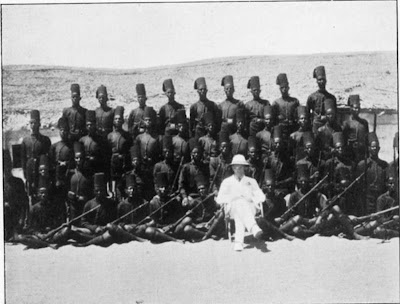grandpakhalif wrote:LOOOOOOL read Voltage's post concerning Ogaden we used and abused British

We use them while they use you miskin

The British Ordered Indian fighters and south african fighters To stop Sheikh basheer al mujaheed
Shiekh Bashir haji yusuf was born in round 1905 in Taleh east of Lasanod.
In 1945, a brave religious leader, Shiekh Bashir Yussuf, who sought to organize himself on the basis similar to that of Mr Omaar, emerged in the former British Somaliland. Shiekh Bashir, was devoutly religious and of philosophical nature, conscientious practice of the mystical sect of Salihiya based in Saudi Arabia. Shiekh Bashir was collecting arms and men with a view to establish his authority over the northeast portion of the protectorate. It was also freely rumoured that it was his ultimate goal; he was strong enough to lead a religious expedition against the British rule. He organized head quarters in the east of Burao region of the former British Somaliland, quickly attracted a following because of his genius and religious influence, and suddenly during May 1945, raided the European Officials and military areas like District Commission’s residence in Burao. In many occasions, hundreds of rounds were fired and before being attacked, he managed to move with his troops during the night and retreated to his domain Bashir’s little force was outnumbered, possibly by 100s. These men held a number of hills, which rose steeply from the light bush beside the wide sandy riverbed, which is known Tog-dheer. There was a few to cover a front of 900 yards, and the most of them had been in action before; but were his determined that no British troops should force their way unchallenged and the fight they put up was a lesson in determination which the British troops signally failed to emulate. Bashir himself was in his natural element when fighting out in the bush, but here he was given a position to hold and, however much stuff the British showered on him. He had no opportunity of using his bush tactics. He just to stay put and take it, and certainly he did this and others well and died in dignity.
The British campaign against him provide abortive after several defeats as his forces kept on moving from one place to another to avoid any permanent location. No sooner had the expedition left for the area, the news traveled fast among the Somali nomads across the plain. The war had exposed the British administration to humiliation especially Mr Jember and his team. The government (the as quite cabinet) came to conclusion one time that another expedition against him would be useless; that they build a railway, make roads and effectively occupy the whole of the protectorate, or else abandon the interior completely. The letter course was decided upon, and during the first months of 1945, the advance posts wren withdrawn and the British administration confined to the coast town i.e. Berbera.
Shiekh Bashir, settled many disputes among the tribes in the vicinity, this kept them from raiding each other, and was generally though to be the side of Islamic Sharia. He accredited with the possession of supper nation of supernatural powers he gathered around him a strong following. Sough after he was eventually killed and became a martyr held in great reverence. The impression then among the British colonial officials in Burao, was the teachings of Farah Omaar of nationalism still remained and were not extinguished
. The British administration had managed to recruit and brought Indian and South African troops to fight against him and had intelligence plans to capture him alive. Those who claimed they had participated the war against him felt cheated of victory and wither away out on the volt than to welcome them back to the fold with a promise rewards. The British administration did not offer back compensation to the families who lost their love once (Muqadamin). Nevertheless, this appreciation is not compensation for the family’s disappointment and abhorrence of the policy of the British government towards the death of Shiekh




